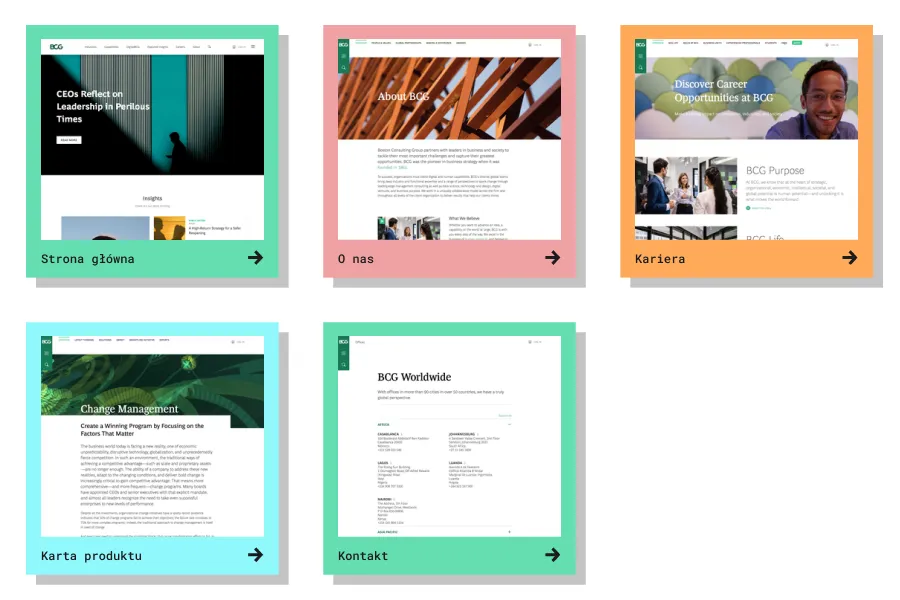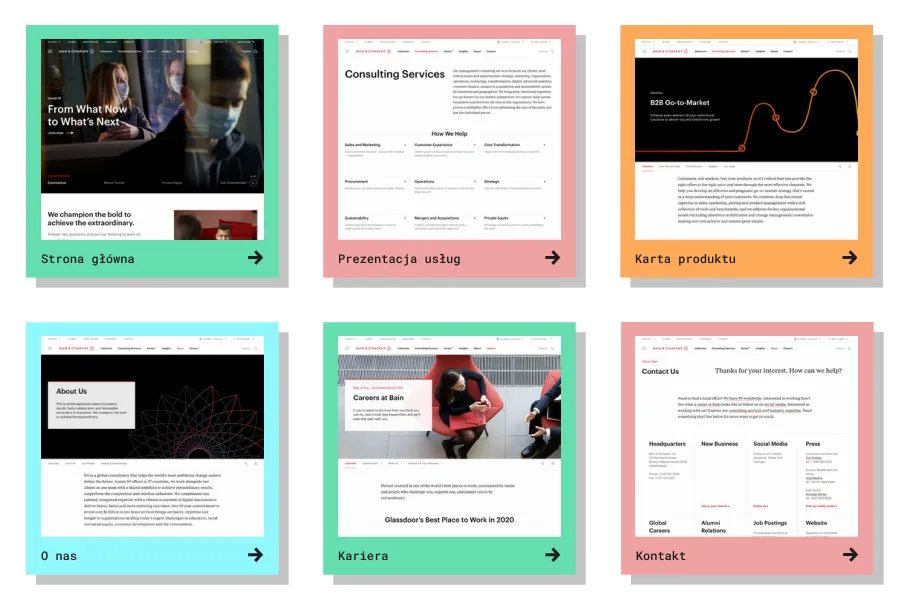One of the essential issues regarding improving conversion in the consulting industry is a quick and complete adaptation of the company website to the changed expectations of the B2B customer (to put it bluntly, it's about achieving a higher conversion rate).
If you're not sure if your website:
- Has full usability
- Provides the expected return on investment (ROI)
- Generates a satisfactory number of leads
- Converts traffic into conversion
- Is prepared to effectively compete in the era of coronavirus.
Then this article will be very helpful to you.
Moreover, you will find out what conversion is (to be precise, what the conversion rate is), and you will read about our research and services (UX Audit for the consulting industry) and the possibilities that the optimization of a website in terms of User Experience (UX) provides.
In summary, you will learn about activities, thanks to which the conversion on your site will increase.
Conversion Rate — definition
For several years, the conversion rate has been one of the most popular indicators used to measure the effectiveness of marketing operations conducted on the Internet (e.g., Google AdWords, Facebook Ads).
With its help, you can estimate and evaluate the effectiveness of an advertisement or landing page and also any element of the website or web application that allows users to perform an action (e.g., call, send an e-mail through a form, make a purchase, download a free e-book or subscribe to a newsletter, etc.).
Conversion can be calculated by dividing the number of performed and desirable actions by the number of all users who, in a given period (for which the conversion is calculated), visited the website, saw a given advertisement, etc.
In this simple but very practical, objective, and measurable way, you can evaluate to what extent the given solution fulfills the expectations.
The higher the conversion rate, the higher the certainty that the implemented solution is effective.
What's more, the conversion is not only calculated but can also be improved (increasing the conversion rate) through the continuous optimization of elements whose effectiveness you're examining.
What is consulting?
To put it simply, consulting means advisory.
For the purposes of this article, we will adopt the most illustrative definition. According to it, consulting is defined as B2B advisory services aimed at improvement of the company's performance over various time frames and in different areas of its operation.
Consulting services are provided by companies that employ high-level experts (often economists, lawyers, management specialists, market analysts, programmers, etc.).
All of this is to deliver the best strategies, analyses, and plans that make it possible to acquire market advantage.
Advantages that help during crises (e.g., the recession of the economy) or make it possible to predict and prepare for them (e.g., in terms of operations, finance, or structure).
In times of bad economic situation, consulting companies play a crucial role in recommendations regarding investments, fusions, or takeovers. The level of complexity of economies and markets means that the demand for these types of services will continue to grow, especially in periods where uncertainty and instability are a temporary norm. Currently, we are in such a situation. Both globally and locally.
Usually, when thinking about consulting, people consider it a service for very large and complex organizations (with elaborate structures of dependencies and elements) that work on diverse markets.
However, consulting has become widespread, and increasingly often, medium-sized companies also start to use the services of consulting companies.
If statistics are to be believed (and no reason says otherwise), 8 of 10 users visiting the websites of consulting companies will look for exhaustive information.
Information that will be the basis for contact. In other words, before the organization decides to contact the consulting company, it will want to make sure that it makes the best choice, naturally, the best choice from the perspective of its needs and problems.
For that to happen, the website must be designed with the specific needs of business users in mind. It has to be a tool for them that they will want to use in a satisfactory way.
Consulting in the era of coronavirus
Before we move on to details, it's worth mentioning a little about the new situation. Market-wise and regarding the marketing strategy side, a lot has changed (mainly in terms of channels and tools). And changes demand a quick, specific, and rational reaction from consulting companies.
The temporary lockdown of the economy, the change in the functioning of the majority of companies and industries (remote work, restructuring of employment), and the economic slowdown have resulted in consulting services to attract business clients of two kinds:
- Those in crisis (e.g., hospitality industry, tourism)
- Those benefiting from the crisis (e.g., E-Commerce).
The standard way of establishing business relationships also has changed. Face-to-face business meetings have lost in popularity in favor of communication through digital channels.
Websites are becoming the primary communication tool that definitely needs to go beyond the bare design minimum found in many guides. In typical recommendations, we can read that the website of a consulting company should be, above all else:
- Simple and clear
- Easy to use
- Oriented on providing engaging content
- Inspire trust
- Clearly convey the Value Proposition and Unique Selling Proposition.
Naturally, these are all important, but they don't exhaust the range of elements that should be taken care of while creating a website of a consulting company from scratch or while optimizing an existing one.
Consulting industry — how to optimize conversion with UX Audit
Although the consulting industry "makes a living" by offering assistance and providing various consulting services (including IT, financial, tax, personal, and image consulting) in the era of the pandemic, it will have to fight for the customer even more.
Especially since their acquisition, as in other industries, will depend on having a perfectly optimized website.
Entirely usable, functional, and refined in terms of UX website requires the change of a few processes that currently overlap:
- Pressure to digitize services and automate processes
- Globalization of provided services
- Economic, organizational, and production crises caused by the coronavirus pandemic.
Change in expectations that result from civilization processes and the current situation means that websites will gain even more significance. Hence, another pressure that should be added to the above factors will be the pressure of the communication strategy, range, and effectiveness of acquiring customers through the Internet.

Currently, it's still an emergency solution (although maybe it will become a preferred one) in industries relying on face-to-face contact and relationships stemming from it.
Nevertheless, the role of establishing and building relationships as well as selling services through the Internet will gain importance. Similarly, a correspondingly high conversion rate gains significance by analogy and interdependence of these phenomena.
The optimization of the conversion rate in the consulting industry
The optimization of a website in terms of UX and the UX Audit preceding it aims to indicate elements, solutions, functionalities, and content that, from the users' perspective, raise the most significant problems.
A website and its content can be seen as incomprehensible, useless, difficult, annoying, and even ugly. Thus it can result in negative opinions and evoke adverse emotions and feelings in terms of the following:
- Cognition, e.g., the website contains complex jargon
- Usability and functions, e.g., the website doesn't solve a business problem
- Emotions, e.g., the website is annoying.
All of this can result in behavioral reactions, that is, rapidly leaving the site or looking for another devoid of such shortcomings.

Optimizing conversion in the consulting industry, fully harnessing the potential of a website, and increasing the conversion rate requires diagnosing all the mistakes, shortcomings, and processes that constitute Conversion Blockers. And this phenomenon applies to all industries.
The improvement of the conversion rate is possible to achieve only based on reliable and thorough research and analyses. Conducted by standard and well-respected methods.
While analyzing selected websites, we've searched for answers to questions such as:
- On what does the low conversion rate in the consulting industry depend?
- Which website elements (e.g., photos, text blocks, buttons) lower the conversion rate?
- Addition or removal of which elements helps increase conversion?
- What functionalities should the website of a consulting company have?
- What primarily influences and determines the willingness to leave a lead?
- How do the layout and the applied design system influence emotions?
- Why do business customers abandon the websites of consulting companies?
- In what way and to what extent the applied technology increases/reduces the conversion rate?
In total, we have performed over 50 website audits that can be set as a model of best UX practices in B2B. Practices, thanks to which the conversion increases. Another goal of research undertaken by our R&D team was to select Optimization Guidelines that would improve the following:
- Usability of the consulting company's website
- Content of the site (regarding texts, audio-visuals, audio, understandability, communicativeness, persuasiveness, and consistency)
- Emotional reactions — increasing satisfaction from use, increasing sympathy, and eliminating the causes of negative feelings
- Navigation, menu, and product and contact pages representing the company and its employees
- Responsiveness — adjusting home page and subpage layouts to the requirements of various mobile devices
- Information Architecture — content readability.
We've combined several methods during research and analyses. We've used Nielsen's Heuristics, Cognitive Journey, and the results of NN Group's report "B2B Website Usability for Converting Users into Leads and Customers".
Having the tools to analyze and quantify problems (more than 400 Indicators in total), we can conduct a thorough, multidimensional examination of the website from your industry. In the UX Audit summary report, we describe, among others:
- B2B customer decision-making process — it allows us to indicate moments and causes of the lack of conversion
- Image requirements that are the most compelling for B2B customers
We also present:
- The List of Bad Practices and Mistakes (knowledge about what doesn't work)
- The List of Best Practices (knowledge about what does work)
- Optimization Recommendations (guidance on "what to change" and "how to change").





